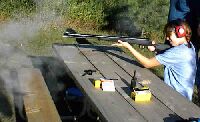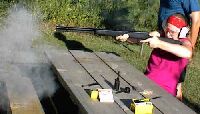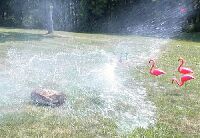by Joe Hecksel
|
There are two big reasons why hunters do not collect the big game they shoot. The first reason is very few hunters can track worth a hoot. The second reason is poor shot placement. The two reasons are related in strange ways. Most hunters are poor trackers because they do not put much effort into it. They think tracking is wasted time because they believe a deer is not mortally wounded if it does not drop within twenty yards of where it was hit. They think, Why bother tracking a deer that is not going to die? Why thrash around in the brush and pollute the hunting when you saw the deer run away? Obviously, deer are much tougher than they used to be. Most hunters are easily seduced by the siren song of the .300 Hyper-Velocity Smokepole Magnum and her sultry sisters. But bigger guns are harder to shoot well because of recoil and muzzle-blast. The problem is made worse because hunters are less likely to practice if the gun is not fun to shoot and it costs a dollar every time they pull the trigger. The best hunting gun is the gun you enjoy shooting and can afford to shoot a lot. Muzzle loaders shooting roundballs are fun and cheap to shoot. Mechanics of recoil: Recoil is the kinetic energy the gun hits the shooter with. Shooters spend a great deal of time studying the downrange energy of the bullet but seldom give any thought to the energy the gun applies to the shooter. Here is a table of some common deer hunting choices:
(Author's note: Prices are the cheapest name-brand ammo from a large sporting goods store. They are what a hunter might pay grabbing it off the shelf. "Powder Weight" and "Muzzle Velocity" data came from loads listed in the Lyman Reloading Handbook, 44th and 46th Editions and from the Lyman Black Powder Handbook & Loading Manual, 2nd Edition.
The formula used for computing "Recoil Energy" came from page 450 of the Lyman Reloading Handbook, 46th Edition. It uses 4,700 as smokeless powder gas velocity and 2,000 as black powder gas velocity. Click here for instructions on how you can download, for free, a Works Spreadsheet containing that formula and several other ballistic and shooting formulas.) A few of points to notice:
You will also hear comments that roundballs do not have enough kinetic energy for deer. The conventional wisdom is that you need 500 ft-lbs, or 800 ft-lbs or 1200 ft-lbs, depending on the author and the cartridge they are selling. Their comments are based on data from small diameter, high velocity rounds that use some of that energy to expand. A roundball at 100 yards is still cooking along at 1000 fps and has over 400 ft-lbs of kinetic energy. And it makes a hole at least 0.50" in diameter, guaranteed! Not enough energy? A broadhead arrow has a little over 50 ft-lbs and does a dandy job of killing deer. It ain't the energy, it is the amount and type of flesh you destroy.
Photos copyright 2002 by Tom Henderson
|


